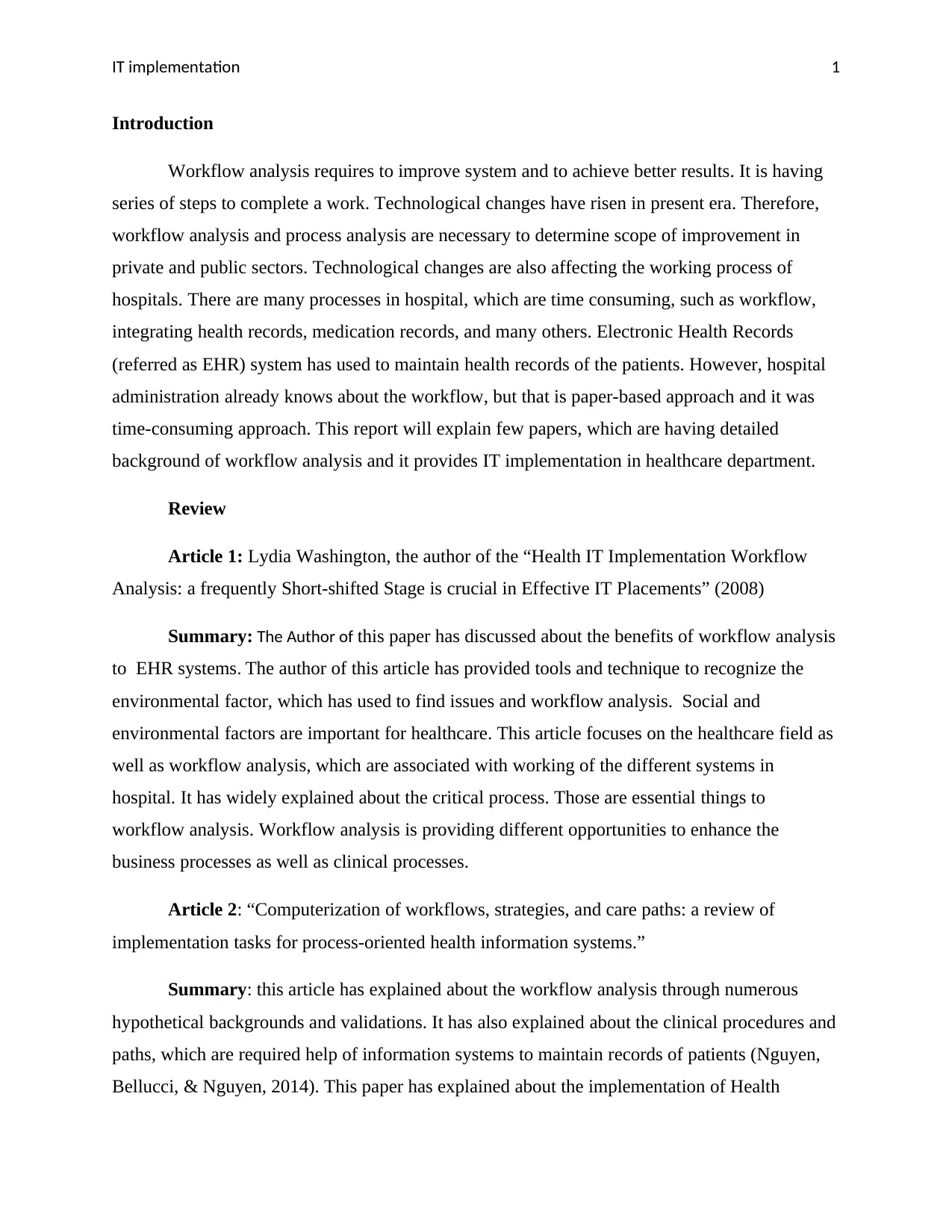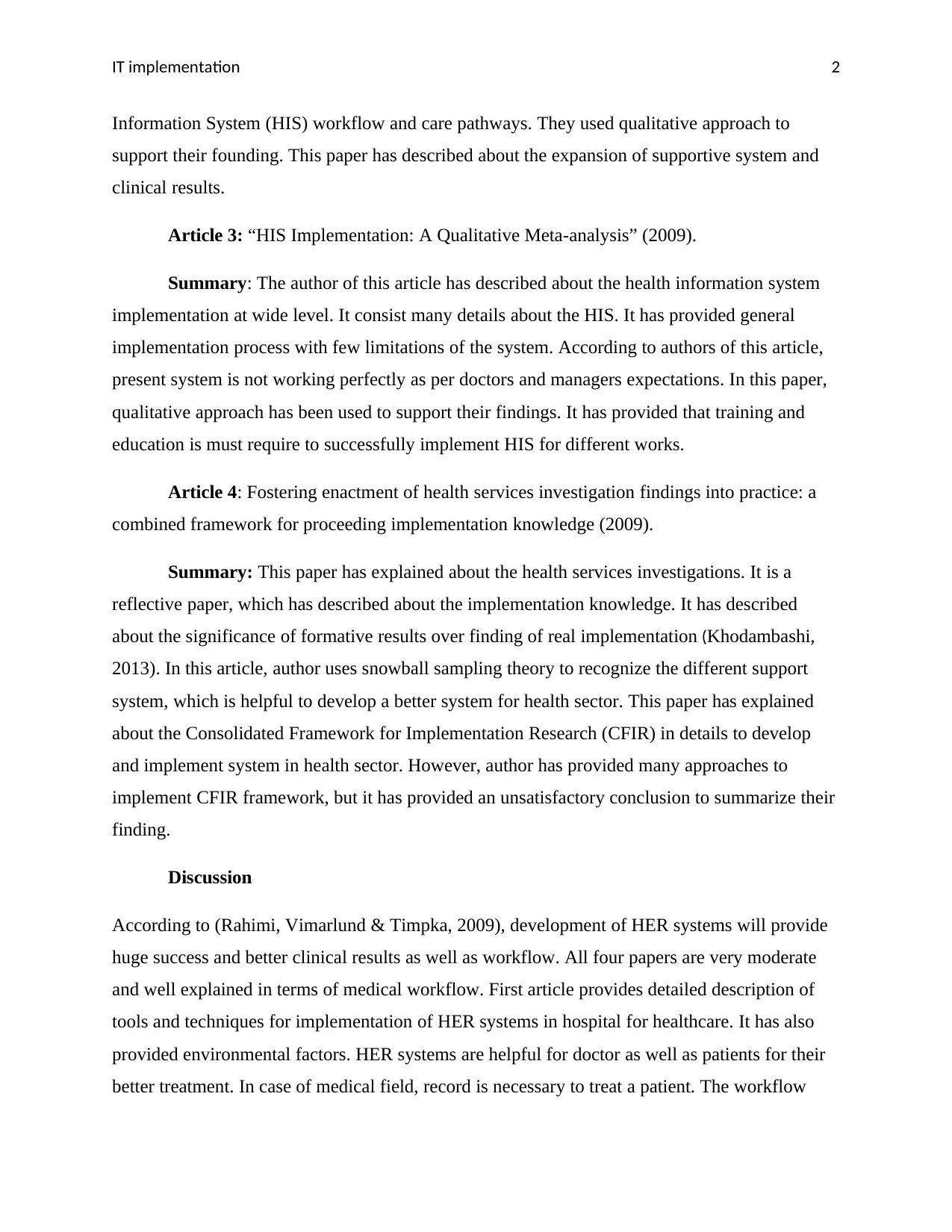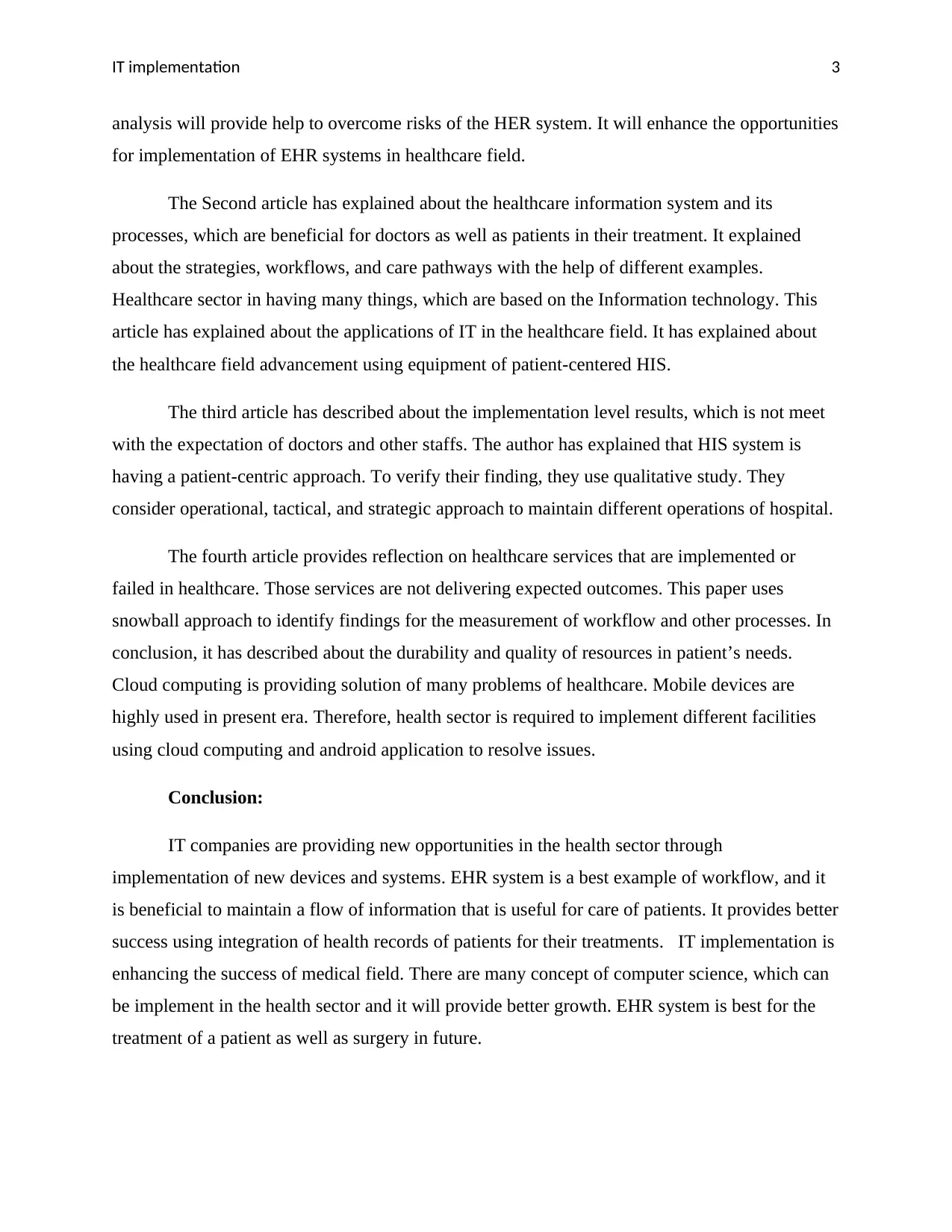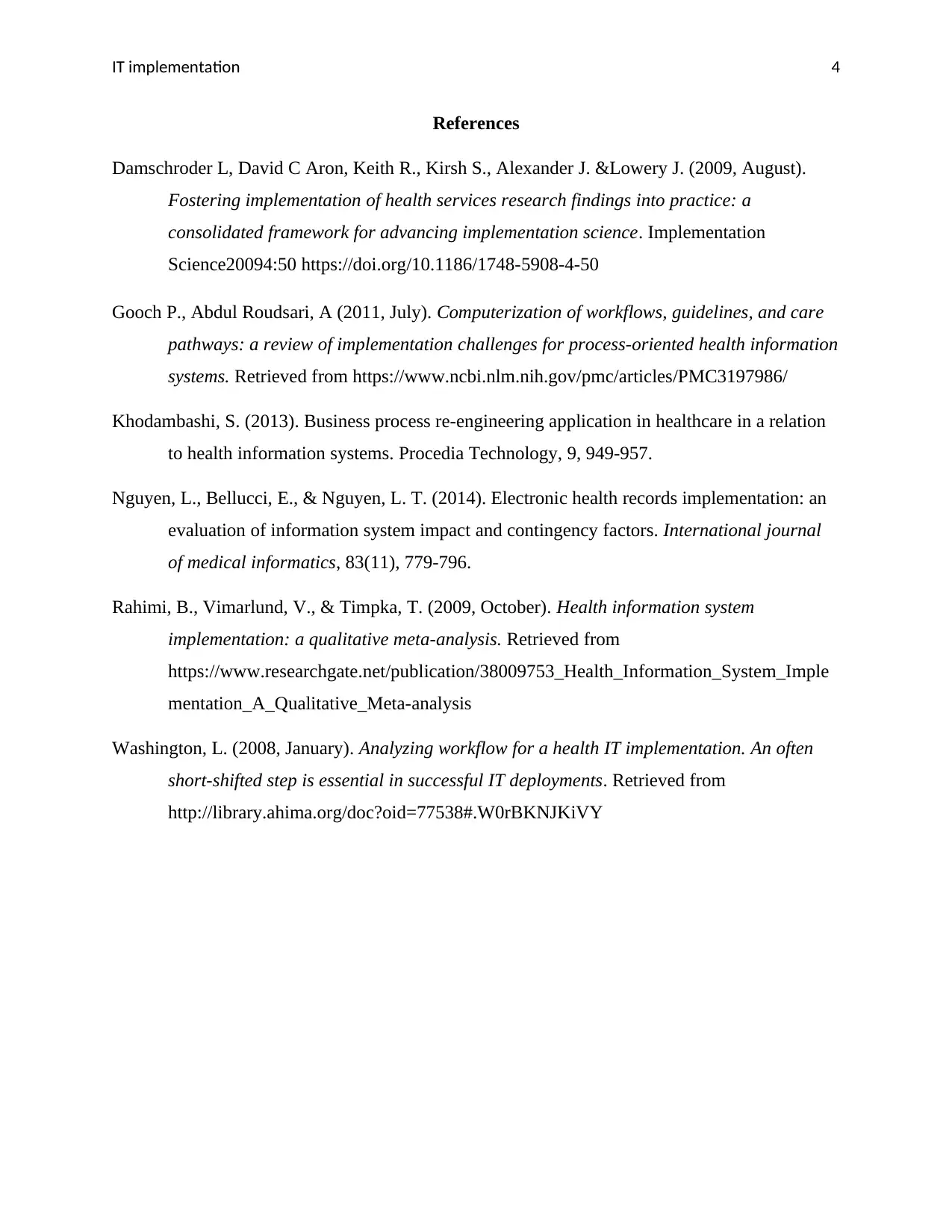HIM6114 - Health IT Implementation: Workflow Analysis and EHR Systems
VerifiedAdded on 2023/04/11
|5
|1193
|429
Literature Review
AI Summary
This literature review examines the implementation of Information Technology (IT) within the healthcare sector, focusing on workflow analysis and its impact on Electronic Health Records (EHR) systems. It reviews several articles discussing the benefits of workflow analysis for EHR implementation, the challenges and strategies for computerizing workflows, and the importance of training and education for successful Health Information System (HIS) implementation. The review highlights the potential of EHR systems to improve clinical outcomes and streamline healthcare processes, while also addressing the limitations and areas for improvement in current HIS implementations. The integration of cloud computing and mobile devices is suggested as a future direction for resolving issues and enhancing healthcare services, ultimately emphasizing the role of IT in advancing the medical field and patient care.

Running Head: IT Implementation 0
IT Implementation
Report
Student name
IT Implementation
Report
Student name
Paraphrase This Document
Need a fresh take? Get an instant paraphrase of this document with our AI Paraphraser

IT implementation 1
Introduction
Workflow analysis requires to improve system and to achieve better results. It is having
series of steps to complete a work. Technological changes have risen in present era. Therefore,
workflow analysis and process analysis are necessary to determine scope of improvement in
private and public sectors. Technological changes are also affecting the working process of
hospitals. There are many processes in hospital, which are time consuming, such as workflow,
integrating health records, medication records, and many others. Electronic Health Records
(referred as EHR) system has used to maintain health records of the patients. However, hospital
administration already knows about the workflow, but that is paper-based approach and it was
time-consuming approach. This report will explain few papers, which are having detailed
background of workflow analysis and it provides IT implementation in healthcare department.
Review
Article 1: Lydia Washington, the author of the “Health IT Implementation Workflow
Analysis: a frequently Short-shifted Stage is crucial in Effective IT Placements” (2008)
Summary: The Author of this paper has discussed about the benefits of workflow analysis
to EHR systems. The author of this article has provided tools and technique to recognize the
environmental factor, which has used to find issues and workflow analysis. Social and
environmental factors are important for healthcare. This article focuses on the healthcare field as
well as workflow analysis, which are associated with working of the different systems in
hospital. It has widely explained about the critical process. Those are essential things to
workflow analysis. Workflow analysis is providing different opportunities to enhance the
business processes as well as clinical processes.
Article 2: “Computerization of workflows, strategies, and care paths: a review of
implementation tasks for process-oriented health information systems.”
Summary: this article has explained about the workflow analysis through numerous
hypothetical backgrounds and validations. It has also explained about the clinical procedures and
paths, which are required help of information systems to maintain records of patients (Nguyen,
Bellucci, & Nguyen, 2014). This paper has explained about the implementation of Health
Introduction
Workflow analysis requires to improve system and to achieve better results. It is having
series of steps to complete a work. Technological changes have risen in present era. Therefore,
workflow analysis and process analysis are necessary to determine scope of improvement in
private and public sectors. Technological changes are also affecting the working process of
hospitals. There are many processes in hospital, which are time consuming, such as workflow,
integrating health records, medication records, and many others. Electronic Health Records
(referred as EHR) system has used to maintain health records of the patients. However, hospital
administration already knows about the workflow, but that is paper-based approach and it was
time-consuming approach. This report will explain few papers, which are having detailed
background of workflow analysis and it provides IT implementation in healthcare department.
Review
Article 1: Lydia Washington, the author of the “Health IT Implementation Workflow
Analysis: a frequently Short-shifted Stage is crucial in Effective IT Placements” (2008)
Summary: The Author of this paper has discussed about the benefits of workflow analysis
to EHR systems. The author of this article has provided tools and technique to recognize the
environmental factor, which has used to find issues and workflow analysis. Social and
environmental factors are important for healthcare. This article focuses on the healthcare field as
well as workflow analysis, which are associated with working of the different systems in
hospital. It has widely explained about the critical process. Those are essential things to
workflow analysis. Workflow analysis is providing different opportunities to enhance the
business processes as well as clinical processes.
Article 2: “Computerization of workflows, strategies, and care paths: a review of
implementation tasks for process-oriented health information systems.”
Summary: this article has explained about the workflow analysis through numerous
hypothetical backgrounds and validations. It has also explained about the clinical procedures and
paths, which are required help of information systems to maintain records of patients (Nguyen,
Bellucci, & Nguyen, 2014). This paper has explained about the implementation of Health

IT implementation 2
Information System (HIS) workflow and care pathways. They used qualitative approach to
support their founding. This paper has described about the expansion of supportive system and
clinical results.
Article 3: “HIS Implementation: A Qualitative Meta-analysis” (2009).
Summary: The author of this article has described about the health information system
implementation at wide level. It consist many details about the HIS. It has provided general
implementation process with few limitations of the system. According to authors of this article,
present system is not working perfectly as per doctors and managers expectations. In this paper,
qualitative approach has been used to support their findings. It has provided that training and
education is must require to successfully implement HIS for different works.
Article 4: Fostering enactment of health services investigation findings into practice: a
combined framework for proceeding implementation knowledge (2009).
Summary: This paper has explained about the health services investigations. It is a
reflective paper, which has described about the implementation knowledge. It has described
about the significance of formative results over finding of real implementation (Khodambashi,
2013). In this article, author uses snowball sampling theory to recognize the different support
system, which is helpful to develop a better system for health sector. This paper has explained
about the Consolidated Framework for Implementation Research (CFIR) in details to develop
and implement system in health sector. However, author has provided many approaches to
implement CFIR framework, but it has provided an unsatisfactory conclusion to summarize their
finding.
Discussion
According to (Rahimi, Vimarlund & Timpka, 2009), development of HER systems will provide
huge success and better clinical results as well as workflow. All four papers are very moderate
and well explained in terms of medical workflow. First article provides detailed description of
tools and techniques for implementation of HER systems in hospital for healthcare. It has also
provided environmental factors. HER systems are helpful for doctor as well as patients for their
better treatment. In case of medical field, record is necessary to treat a patient. The workflow
Information System (HIS) workflow and care pathways. They used qualitative approach to
support their founding. This paper has described about the expansion of supportive system and
clinical results.
Article 3: “HIS Implementation: A Qualitative Meta-analysis” (2009).
Summary: The author of this article has described about the health information system
implementation at wide level. It consist many details about the HIS. It has provided general
implementation process with few limitations of the system. According to authors of this article,
present system is not working perfectly as per doctors and managers expectations. In this paper,
qualitative approach has been used to support their findings. It has provided that training and
education is must require to successfully implement HIS for different works.
Article 4: Fostering enactment of health services investigation findings into practice: a
combined framework for proceeding implementation knowledge (2009).
Summary: This paper has explained about the health services investigations. It is a
reflective paper, which has described about the implementation knowledge. It has described
about the significance of formative results over finding of real implementation (Khodambashi,
2013). In this article, author uses snowball sampling theory to recognize the different support
system, which is helpful to develop a better system for health sector. This paper has explained
about the Consolidated Framework for Implementation Research (CFIR) in details to develop
and implement system in health sector. However, author has provided many approaches to
implement CFIR framework, but it has provided an unsatisfactory conclusion to summarize their
finding.
Discussion
According to (Rahimi, Vimarlund & Timpka, 2009), development of HER systems will provide
huge success and better clinical results as well as workflow. All four papers are very moderate
and well explained in terms of medical workflow. First article provides detailed description of
tools and techniques for implementation of HER systems in hospital for healthcare. It has also
provided environmental factors. HER systems are helpful for doctor as well as patients for their
better treatment. In case of medical field, record is necessary to treat a patient. The workflow
⊘ This is a preview!⊘
Do you want full access?
Subscribe today to unlock all pages.

Trusted by 1+ million students worldwide

IT implementation 3
analysis will provide help to overcome risks of the HER system. It will enhance the opportunities
for implementation of EHR systems in healthcare field.
The Second article has explained about the healthcare information system and its
processes, which are beneficial for doctors as well as patients in their treatment. It explained
about the strategies, workflows, and care pathways with the help of different examples.
Healthcare sector in having many things, which are based on the Information technology. This
article has explained about the applications of IT in the healthcare field. It has explained about
the healthcare field advancement using equipment of patient-centered HIS.
The third article has described about the implementation level results, which is not meet
with the expectation of doctors and other staffs. The author has explained that HIS system is
having a patient-centric approach. To verify their finding, they use qualitative study. They
consider operational, tactical, and strategic approach to maintain different operations of hospital.
The fourth article provides reflection on healthcare services that are implemented or
failed in healthcare. Those services are not delivering expected outcomes. This paper uses
snowball approach to identify findings for the measurement of workflow and other processes. In
conclusion, it has described about the durability and quality of resources in patient’s needs.
Cloud computing is providing solution of many problems of healthcare. Mobile devices are
highly used in present era. Therefore, health sector is required to implement different facilities
using cloud computing and android application to resolve issues.
Conclusion:
IT companies are providing new opportunities in the health sector through
implementation of new devices and systems. EHR system is a best example of workflow, and it
is beneficial to maintain a flow of information that is useful for care of patients. It provides better
success using integration of health records of patients for their treatments. IT implementation is
enhancing the success of medical field. There are many concept of computer science, which can
be implement in the health sector and it will provide better growth. EHR system is best for the
treatment of a patient as well as surgery in future.
analysis will provide help to overcome risks of the HER system. It will enhance the opportunities
for implementation of EHR systems in healthcare field.
The Second article has explained about the healthcare information system and its
processes, which are beneficial for doctors as well as patients in their treatment. It explained
about the strategies, workflows, and care pathways with the help of different examples.
Healthcare sector in having many things, which are based on the Information technology. This
article has explained about the applications of IT in the healthcare field. It has explained about
the healthcare field advancement using equipment of patient-centered HIS.
The third article has described about the implementation level results, which is not meet
with the expectation of doctors and other staffs. The author has explained that HIS system is
having a patient-centric approach. To verify their finding, they use qualitative study. They
consider operational, tactical, and strategic approach to maintain different operations of hospital.
The fourth article provides reflection on healthcare services that are implemented or
failed in healthcare. Those services are not delivering expected outcomes. This paper uses
snowball approach to identify findings for the measurement of workflow and other processes. In
conclusion, it has described about the durability and quality of resources in patient’s needs.
Cloud computing is providing solution of many problems of healthcare. Mobile devices are
highly used in present era. Therefore, health sector is required to implement different facilities
using cloud computing and android application to resolve issues.
Conclusion:
IT companies are providing new opportunities in the health sector through
implementation of new devices and systems. EHR system is a best example of workflow, and it
is beneficial to maintain a flow of information that is useful for care of patients. It provides better
success using integration of health records of patients for their treatments. IT implementation is
enhancing the success of medical field. There are many concept of computer science, which can
be implement in the health sector and it will provide better growth. EHR system is best for the
treatment of a patient as well as surgery in future.
Paraphrase This Document
Need a fresh take? Get an instant paraphrase of this document with our AI Paraphraser

IT implementation 4
References
Damschroder L, David C Aron, Keith R., Kirsh S., Alexander J. &Lowery J. (2009, August).
Fostering implementation of health services research findings into practice: a
consolidated framework for advancing implementation science. Implementation
Science20094:50 https://doi.org/10.1186/1748-5908-4-50
Gooch P., Abdul Roudsari, A (2011, July). Computerization of workflows, guidelines, and care
pathways: a review of implementation challenges for process-oriented health information
systems. Retrieved from https://www.ncbi.nlm.nih.gov/pmc/articles/PMC3197986/
Khodambashi, S. (2013). Business process re-engineering application in healthcare in a relation
to health information systems. Procedia Technology, 9, 949-957.
Nguyen, L., Bellucci, E., & Nguyen, L. T. (2014). Electronic health records implementation: an
evaluation of information system impact and contingency factors. International journal
of medical informatics, 83(11), 779-796.
Rahimi, B., Vimarlund, V., & Timpka, T. (2009, October). Health information system
implementation: a qualitative meta-analysis. Retrieved from
https://www.researchgate.net/publication/38009753_Health_Information_System_Imple
mentation_A_Qualitative_Meta-analysis
Washington, L. (2008, January). Analyzing workflow for a health IT implementation. An often
short-shifted step is essential in successful IT deployments. Retrieved from
http://library.ahima.org/doc?oid=77538#.W0rBKNJKiVY
References
Damschroder L, David C Aron, Keith R., Kirsh S., Alexander J. &Lowery J. (2009, August).
Fostering implementation of health services research findings into practice: a
consolidated framework for advancing implementation science. Implementation
Science20094:50 https://doi.org/10.1186/1748-5908-4-50
Gooch P., Abdul Roudsari, A (2011, July). Computerization of workflows, guidelines, and care
pathways: a review of implementation challenges for process-oriented health information
systems. Retrieved from https://www.ncbi.nlm.nih.gov/pmc/articles/PMC3197986/
Khodambashi, S. (2013). Business process re-engineering application in healthcare in a relation
to health information systems. Procedia Technology, 9, 949-957.
Nguyen, L., Bellucci, E., & Nguyen, L. T. (2014). Electronic health records implementation: an
evaluation of information system impact and contingency factors. International journal
of medical informatics, 83(11), 779-796.
Rahimi, B., Vimarlund, V., & Timpka, T. (2009, October). Health information system
implementation: a qualitative meta-analysis. Retrieved from
https://www.researchgate.net/publication/38009753_Health_Information_System_Imple
mentation_A_Qualitative_Meta-analysis
Washington, L. (2008, January). Analyzing workflow for a health IT implementation. An often
short-shifted step is essential in successful IT deployments. Retrieved from
http://library.ahima.org/doc?oid=77538#.W0rBKNJKiVY
1 out of 5
Related Documents
Your All-in-One AI-Powered Toolkit for Academic Success.
+13062052269
info@desklib.com
Available 24*7 on WhatsApp / Email
![[object Object]](/_next/static/media/star-bottom.7253800d.svg)
Unlock your academic potential
Copyright © 2020–2025 A2Z Services. All Rights Reserved. Developed and managed by ZUCOL.




